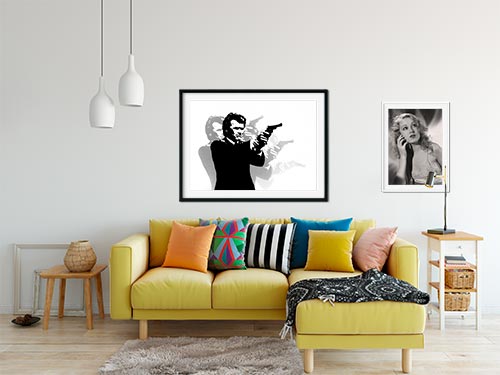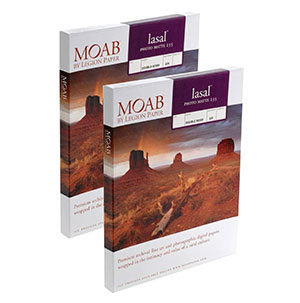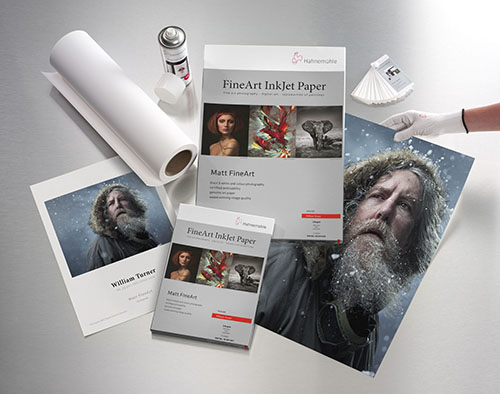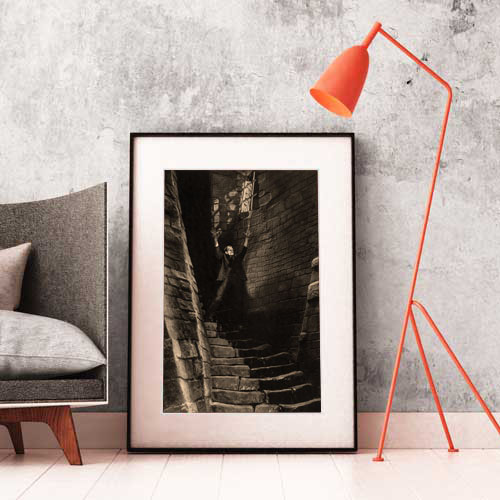Stunning theatrical publicity shot featuring Christopher Lee (Count Dracula) preparing to bite Caroline Munro's (Laura Bellows) neck which is already covered with blood. Christopher Neame (Alucard) persuades Jessica Van Helsing (Stephanie Beacham) and the others to attend a Black Mass ceremony in the now abandoned, de-consecrated St Bartolph's, where he performs a bloody ritual involving one of their group, Laura Bellows. Jessica and the others flee in horror, after which Count Dracula is resurrected and kills Laura (the photo shown).
Dracula A.D. 1972 is a 1972 British horror film, directed by Alan Gibson and produced by Hammer Film Productions. It was written by Don Houghton and stars Christopher Lee, Peter Cushing and Stephanie Beacham. Unlike earlier films in Hammer's Dracula series, Dracula A.D. 1972 had a contemporary setting in an attempt to update the Dracula story for modern audiences. Dracula is brought back to life in modern London and preys on a group of young partygoers that includes the descendant of his nemesis, Van Helsing. It is the seventh Hammer film featuring Dracula, and the sixth to star Christopher Lee in the title role.
It also marked the return of Peter Cushing as Van Helsing for the first time since The Brides of Dracula (1960), and was the first to feature both Lee and Cushing in their respective roles since Dracula (1958).It was followed by the last film in Hammer's Dracula series to star Christopher Lee, The Satanic Rites of Dracula, which similarly utilized a modern setting and featured most of the same central characters. Following the success of the modern-day vampire film Count Yorga, Vampire, Warner Bros commissioned two Hammer Dracula films set in the present day, which were to become Dracula A.D. 1972 and The Satanic Rites of Dracula. The film was inspired by the events surrounding the Highgate Vampire case.
For the Black Mass segment, the film used the track "Black Mass: An Electric Storm in Hell" by the pioneering electronic group White Noise, from their 1969 album An Electric Storm; Neame's dialogue was later sampled by Orbital for "Satan Live" and "Tension". The film's opening sequence was not in the previous film, Scars of Dracula (1970), but is completely new and sets up a new short series of the Hammer Horror Dracula chronology finishing in the following film, The Satanic Rites of Dracula (1973). This film's prologue takes place in 1872 and therefore is impossible to reconcile with the previous films in the series, the chronology of which starts in 1885 as described in the 1958 original.
While the two present-day Dracula films star both Lee and Cushing, they do not correspond to the chronology established in the Victorian/Edwardian-era films; the first Hammer Dracula film, Dracula, is set in the 1880s, whereas the flashback sequence of the last battle between Van Helsing and Dracula in Dracula A.D. 1972 is set in 1872—long before the first meeting of Van Helsing and Dracula in the original film. American film director Tim Burton at one point claimed it to be among his favorite films, and English author, film critic and horror expert Kim Newman chose it as one of his top 10 favorite vampire movies. In the 2020 BBC/Netflix Dracula miniseries, the third episode is in itself an homage to the film, taking place in present day. It also includes references to it along with many other Hammer Dracula films.
Product Enquiry
Kodak Professional Endura Paper
Kodak Endura papers provide an incredible amount of detail and smooth transition of tones. Designed for the professional photographer in mind, looking for a more traditional photo print style, Kodak Endura provides an extended print life and color gamut almost at the level of a high end fine art paper print.
Archival Matte Paper
Archival Matte Paper, also known as Moab Lasal Photo Matte, is our house stock fine art paper and is an economical favorite for fine art reproductions and photo prints. It features a smooth surface, heavy weight (230 g, 9.5-mil), neutral white, matte paper engineered for accurate color reproduction that provides high contrast and high-resolution output. This paper is acid-free, making it the perfect choice for both photography & fine art reproductions.
Giclee William Turner Paper by Hahnemühle
The William Turner by Hahnemühle is one of the most popular papers used in the Giclee printing industry. This is a 310g natural white mould made natural line paper with 100% rag content making it highly archival. It has a slight coarse texture which gives photos and artwork an elegant look. These fine art paper prints (also known as Giclee) are ordered by galleries, individual artists and photographers. The papers and inks are not only archival but use some of the most accurate print technology for full color prints.
- Giclee prints use very expensive archival pigmented inks.
- Highest level of color gamut available in printing (12 color printing).
- Exceptional black & white printing.
- Fade resistant, pigmented inks which provide a superior color range compared to other types of inks. Widely preferred in fine art and photography circles.
- We ONLY use professional grade fine art and photo paper that resist yellowing and aging.



Framing
We offer wood and metal frames, custom cut & joined to order. Each framed print includes hanging hardware and foamcore backer.
Matting
We use conservation grade 100% virgin alpha-cellulose 2 ply mats with white core. Acid-free and lignin-free, these are both face resistant and meet all conservation quality standards set by the Fine Art Trade Guild. Mats are digitally cut for ultimate precision. The window will be 1/8″ smaller than the print dimensions.
Glazing (Acrylic Glass)
We offer custom cut panes of shatter-proof, acrylic glass, to protect your valuable artwork and prints.
Premium Clear
Framing grade clear acrylic is shatter resistant and lightweight.
Reflection Control
With its matte finish, Tru Vue Reflection Control® Acrylic scatters light to diminish unwanted glare.
Conservation Clear
Tru Vue Conservation Clear® Acrylic is a framing industry staple, blocking up to 99% of UV rays for ultimate protection.
Conservation Reflection Control
Tru Vue Conservation Reflection Control® Acrylic scatters and diffuses light to reduce unwanted glare. Blocks up to 99% of UV rays.







